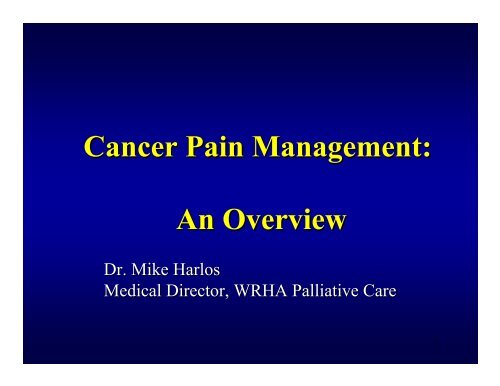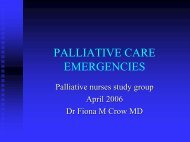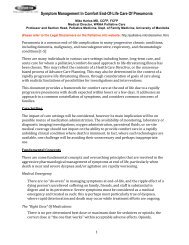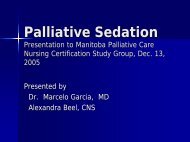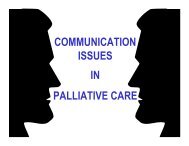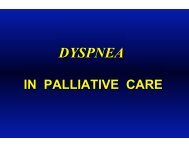Cancer Pain Management: An Overview - Palliative.info
Cancer Pain Management: An Overview - Palliative.info
Cancer Pain Management: An Overview - Palliative.info
Create successful ePaper yourself
Turn your PDF publications into a flip-book with our unique Google optimized e-Paper software.
<strong>Cancer</strong> <strong>Pain</strong> <strong>Management</strong>:<br />
<strong>An</strong> <strong>Overview</strong><br />
Dr. Mike Harlos<br />
Medical Director, WRHA <strong>Palliative</strong> Care<br />
1
<strong>Pain</strong><br />
<strong>An</strong> unpleasant sensory and emotional<br />
experience associated with actual or<br />
potential tissue damage, or described in<br />
terms of such damage.<br />
International Association for the Study of <strong>Pain</strong><br />
2
PHYSICAL<br />
PSYCHOSOCIAL<br />
SUFFERING<br />
EMOTIONAL<br />
SPIRITUAL<br />
3
SYMPTOMS IN ADVANCED CANCER<br />
Ref: Bruera 1992 “Why Do We Care” Conference; Memorial Sloan-Kettering<br />
Asthenia<br />
<strong>An</strong>orexia<br />
<strong>Pain</strong><br />
Nausea<br />
Constipation<br />
Sedation/Confusion<br />
Dyspnea<br />
% Patients (n=275)<br />
0 10 20 30 40 50 60 70 80 90<br />
4
Symptoms At The End of Life in Children With <strong>Cancer</strong><br />
90<br />
80<br />
70<br />
Wolfe J. et al, NEJM 2000; 342(5) p 326-333<br />
Present<br />
Caused "A Great Deal" or "A Lot" of Suffering<br />
Treated<br />
Successfully Treated<br />
%<br />
60<br />
50<br />
40<br />
30<br />
20<br />
10<br />
0<br />
<strong>Pain</strong> Dyspnea Nausea and Vomiting<br />
5
TYPES OF PAIN<br />
NOCICEPTIVE<br />
NEUROPATHIC<br />
Somatic<br />
• bones, joints<br />
• connective tissues<br />
• muscles<br />
Visceral<br />
• Organs –<br />
heart, liver,<br />
pancreas, gut,<br />
etc.<br />
Deafferentation<br />
Sympathetic<br />
Maintained<br />
Peripheral<br />
6
Somatic <strong>Pain</strong><br />
• Aching, often constant<br />
• May be dull or sharp<br />
• Often worse with movement<br />
• Well localized<br />
Eg/<br />
– Bone & soft tissue<br />
– chest wall<br />
7
Bone <strong>Pain</strong><br />
• bone is the most common site of tumour metastases<br />
Primary Tumour<br />
Breast<br />
Prostate<br />
Lung<br />
Bladder<br />
Kidney, Thyroid<br />
Bone Mets %<br />
50 – 85<br />
60 – 85<br />
64<br />
42<br />
28 - 60<br />
Mundy GR. In: Bone Remodeling and Its Disorders. 1995:104-107.<br />
8
Special Considerations in Bone <strong>Pain</strong><br />
• Spinal cord compression in vertebral mets:<br />
<strong>Pain</strong> = earliest feature<br />
• Risk of pathological fracture<br />
Indications for prophylactic surgery in large, weight-<br />
bearing bones<br />
– Cortical Lesions<br />
• Destruction of > 50% of the cortical width<br />
• Axial length of lesion > diameter of the bone<br />
> 2 – 3 cm lesion<br />
– Medullary lesions<br />
• Lesion > 50% of the medulla<br />
• <strong>Pain</strong> unrelieved by radiotherapy<br />
9
Visceral <strong>Pain</strong><br />
• Constant or crampy<br />
• Aching<br />
• Poorly localized<br />
• Referred<br />
Eg/<br />
– CA pancreas<br />
– Liver capsule distension<br />
– Bowel obstruction<br />
10
FEATURES OF NEUROPATHIC PAIN<br />
COMPONENT<br />
Steady, Dysesthetic<br />
DESCRIPTORS<br />
• Burning, Tingling<br />
• Constant, Aching<br />
• Squeezing, Itching<br />
• Allodynia<br />
• Hypersthesia<br />
EXAMPLES<br />
• Diabetic neuropathy<br />
• Post-herpetic neuropathy<br />
Paroxysmal,<br />
Neuralgic<br />
•Stabbing<br />
• Shocklike, electric<br />
• Shooting<br />
• Lancinating<br />
• trigeminal neuralgia<br />
• may be a component of<br />
any neuropathic pain<br />
11
PAIN ASSESSMENT<br />
• Description: severity, quality, location,<br />
temporal features, frequency, aggravating<br />
& alleviating factors<br />
• Previous history<br />
• Context: social, cultural, emotional,<br />
spiritual factors<br />
• Meaning<br />
• Interventions: what has been tried<br />
12
Assessment of Bone <strong>Pain</strong><br />
History:<br />
Physical:<br />
Investigations:<br />
• Continuous, localized, dull pain<br />
• Increases with local pressure<br />
• Incident pain<br />
• Local tenderness<br />
• Neuro assessment, especially in vertebral<br />
mets (spinal cord compression)<br />
• Plain Xrays: specific but not sensitive<br />
• Bone scan: sensitive (except myeloma);<br />
False (+)ve rate 40 – 50%<br />
• CT/MRI – when suspect spinal cord<br />
compression, or results of other investig. neg.<br />
13
Medication(s) taken<br />
• Dose<br />
• Route<br />
• Frequency<br />
• Duration<br />
• Efficacy<br />
• Side effects<br />
14
W.H.O. . ANALGESIC LADDER<br />
By the<br />
Clock<br />
1<br />
Non-opioid<br />
opioid<br />
+/- adjuvant<br />
2<br />
Weak opioid<br />
+/- adjuvant<br />
3<br />
Strong opioid<br />
+/- adjuvant<br />
<strong>Pain</strong> persists or increases<br />
15
STRONG OPIOIDS<br />
• most commonly use:<br />
– morphine<br />
– hydromorphone<br />
– transdermal fentanyl (Duragesic®)<br />
– oxycodone<br />
– Methadone<br />
• DO NOT use meperidine (Demerol ® ) long-term<br />
– active metabolite normeperidine → seizures<br />
16
OPIOIDS and<br />
INCOMPLETE CROSS-TOLERANCE<br />
• conversion tables assume full cross-tolerance<br />
• cross-tolerance unpredictable, especially in:<br />
– high doses<br />
– long-term use<br />
• divide calculated dose in ½ and titrate<br />
17
CONVERTING OPIOIDS<br />
NB: Does not consider incomplete cross-tolerance<br />
Medication<br />
Morphine<br />
Hydromorphone<br />
Methadone<br />
Codeine<br />
Approx. Equiv.<br />
Oral Dose (mg)<br />
10<br />
2<br />
1<br />
60<br />
18
CONVERTING OPIOIDS<br />
NB: Does not consider incomplete cross-tolerance<br />
Drug<br />
Hydromorphone<br />
Oxycodone<br />
Codeine<br />
Approximate Equipotency with<br />
Morphine<br />
(Morphine:Drug)<br />
5:1<br />
1.5:1 to 2:1<br />
1:12<br />
Daily Morphine Dose<br />
Methadone<br />
30 – 90 mg<br />
90 – 300 mg<br />
> 300 mg<br />
Fentanyl<br />
3.7:1<br />
7.75:1<br />
12.75:1<br />
80:1 to 100:1 (for subcutaneous dosing of<br />
each)<br />
19
TITRATING OPIOIDS<br />
• dose increase depends on the situation<br />
• dose ↑ by 25 - 100%<br />
EXAMPLE: (doses in mg q4h)<br />
Morphine 5 10 15 20 25 30 40 50 60<br />
Hydromorphone 1 2 3 4 5 6 8 10 12<br />
20
TOLERANCE<br />
PHYSICAL<br />
DEPENDENCE<br />
PSYCHOLOGICAL<br />
DEPENDENCE /<br />
ADDICTION<br />
24
TOLERANCE<br />
Inturrisi C, Hanks G. Oxford Textbook of <strong>Palliative</strong> Medicine 1993: Chapter 4.2.3<br />
A normal physiological<br />
phenomenon in which<br />
increasing doses are required<br />
to produce the same effect<br />
25
PHYSICAL DEPENDENCE<br />
Inturrisi C, Hanks G. Oxford Textbook of <strong>Palliative</strong> Medicine 1993: Chapter 4.2.3<br />
A normal physiological phenomenon<br />
in which a withdrawal syndrome occurs<br />
when an opioid is abruptly discontinued<br />
or an opioid antagonist is administered<br />
26
PSYCHOLOGICAL DEPENDENCE<br />
and ADDICTION<br />
Inturrisi C, Hanks G. Oxford Textbook of <strong>Palliative</strong> Medicine 1993: Chapter 4.2.3<br />
A pattern of drug use characterized by<br />
a continued craving for an opioid<br />
which is manifest as compulsive drugseeking<br />
behaviour leading to an<br />
overwhelming involvement in the use<br />
and procurement of the drug<br />
27
In chronic opioid dosing:<br />
po / sublingual / rectal routes<br />
reduce by ½<br />
sq / iv / IM routes<br />
28
Using Opioids for Breakthrough <strong>Pain</strong><br />
• Patient must feel in control, empowered<br />
• Use aggressive dose and interval<br />
Patient Taking Short-Acting Opioids:<br />
• 50 - 100% of the q4h dose given q1h prn<br />
Patient Taking Long-Acting Opioids:<br />
• 10 - 20% of total daily dose given q1h prn<br />
with short-acting opioid preparation<br />
29
<strong>Management</strong> of Bone <strong>Pain</strong><br />
Pharmacologic treatment<br />
• Acetaminophen<br />
• Opioids<br />
• NSAIDs: conventional & Cox-2 2 inhibitors<br />
• Corticosteroids (not with NSAIDS)<br />
• Bisphosphonates: pamidronate (Aredia ® ),<br />
clodronate (Bonefos ® ), zoledronate (Zometa ® )<br />
30
<strong>Management</strong> of Bone <strong>Pain</strong> ctd<br />
Radiation treatment<br />
• Single (800 cGy) or Multiple fx (200 cGy x 3-5)<br />
• Effective immediately<br />
• Maximal effect 4 - 6 wks<br />
• 60-80% pts get relief<br />
• Strontium-89<br />
31
Treatment of Neuropathic <strong>Pain</strong><br />
Pharmacologic treatment<br />
• Opioids<br />
• Steroids<br />
• <strong>An</strong>ticonvulsants - gabapentin<br />
• TCAs (for dysesthetic pain, esp. if depression)<br />
• NMDA receptor antagonists: ketamine,<br />
dextromethorphan, methadone<br />
• <strong>An</strong>esthetics<br />
Radiation therapy<br />
Interventional treatment<br />
• Spinal analgesia<br />
• Nerve blocks<br />
32
ADJUVANT DRUGS<br />
• primary indication usually other than pain<br />
• analgesic in some painful conditions<br />
• enhance analgesia of opioids<br />
• other roles:<br />
– treat opioid side effects<br />
– treat symptoms associated with pain<br />
33
CORTICOSTEROIDS AS ADJUVANTS<br />
• ↓ inflammation<br />
• ↓ edema<br />
}<br />
↓ tumor mass<br />
effects<br />
• ↓ spontaneous nerve depolarization<br />
34
CORTICOSTEROIDS: ADVERSE EFFECTS<br />
IMMEDIATE<br />
• Psychiatric<br />
• Hyperglycemia<br />
• ↑ risk of GI bleed<br />
‣ gastritis<br />
‣ aggravation of<br />
existing lesion<br />
(ulcer, tumor)<br />
• Immunosuppression<br />
LONG-TERM<br />
• Proximal myopathy<br />
** often < 15 days **<br />
• Cushing’s syndrome<br />
• Osteoporosis<br />
• Aseptic / avascular<br />
necrosis of bone<br />
35
DEXAMETHASONE: DOSING<br />
• minimal mineralcorticoid effects<br />
– po/iv/sq/sublingual routes<br />
• can be given once/day; often given<br />
bid – qid to facilitate titration<br />
• typically administer as follows:<br />
» 4 mg qid x 7 days then<br />
» 4 mg tid x 1 day then<br />
» 4 mg bid x 1 day then<br />
» 4 mg once/day x 1 day then D/C<br />
36
Complementary / Alternative Therapies<br />
• Acupuncture<br />
• Cognitive/behavioral therapy<br />
• Meditation/relaxation<br />
• Guided imagery<br />
• Herbal preparations<br />
• Magnets<br />
• Therapeutic massage<br />
37
Opioid Side Effects<br />
• Constipation<br />
• Nausea/vomiting<br />
• Urinary retention<br />
• Itch/rash<br />
• Dry mouth<br />
• Respiratory depression<br />
• Drug interactions<br />
• Neurotoxicity: delirium, myoclonus → seizures<br />
38
Opioid-Induced Neurotoxicity (OIN)<br />
• Potentially fatal neuropsychiatric syndrome of:<br />
– Cognitive dysfunction<br />
– Delirium<br />
– Hallucinations<br />
– Myoclonus/seizures<br />
– Hyperalgesia / allodynia<br />
• Increasing incidence – practitioners more<br />
comfortable and aggressive with opioids<br />
• NMDA receptor involved<br />
• Early recognition is critical<br />
39
OIN: Recognition<br />
• Myoclonus – twitching of large muscle groups<br />
• Delirium<br />
• Rapidly escalating dose requirement<br />
• <strong>Pain</strong> “doesn’t t make sense”; ; not consistent with recent<br />
pattern or known disease<br />
40
OIN: Treatment<br />
• Switch opioid (rotation) or reduce opioid dose<br />
• Hydration<br />
• Benzodiazepines for neuromuscular excitation<br />
42
The <strong>Management</strong> of<br />
Incident <strong>Pain</strong><br />
in <strong>Palliative</strong> Care<br />
43
What is Incident <strong>Pain</strong><br />
<strong>Pain</strong> occurring as a direct<br />
and immediate consequence<br />
of a movement or activity<br />
44
Circumstances In Which<br />
Incident <strong>Pain</strong> Often Occurs<br />
• Bone metastases<br />
• Neuropathic pain<br />
• Intra-abdominal abdominal disease aggravated by respiration<br />
» “incident” = breathing<br />
» ruptured viscus, peritonitis, liver hemorrhage<br />
• Skin ulcer: dressing change, debridement<br />
• Disimpaction<br />
• Catheterization<br />
45
Barriers to Managing<br />
Incident <strong>Pain</strong><br />
• common opioids outlast painful stimulus<br />
• opioid dose for incident pain may far exceed<br />
that needed for background pain control<br />
• may be little warning of incident<br />
• effective premedication before activity is<br />
time consuming<br />
46
Having a steady level of enough opioid to treat<br />
the peaks of incident pain...<br />
<strong>Pain</strong><br />
...would result in<br />
excessive dosing<br />
for the periods<br />
between<br />
incidents<br />
Incident Incident Incident<br />
Time<br />
47
Considerations In<br />
Managing Incident <strong>Pain</strong><br />
• usually predictable<br />
• stimulus is usually brief<br />
• frequency of incidents may vary from<br />
several per minute to once per day or<br />
less.<br />
48
Approach to Incident <strong>Pain</strong><br />
• treat underlying problem<br />
» radiation Tx, chemotherapy<br />
» bisphosphonates<br />
» orthopedic intervention<br />
» nerve blocks<br />
• ideal analgesic:<br />
» easily administered<br />
» rapid onset<br />
» short-duration of action<br />
» in patient’s s control<br />
49
Fentanyl and Sufentanil<br />
• synthetic µ agonist opioids<br />
• highly lipid soluble →<br />
» transmucosal absorption<br />
» rapid redistribution, including in / out of CSF<br />
• fentanyl ≈ 100x stronger than morphine<br />
• sufentanil ≈ 1000x stronger than morphine<br />
10 mg morphine<br />
≈ 10 µg g sufentanil<br />
≈ 100 µg g fentanyl<br />
50
Comparison of Fentanyl and Sufentanil<br />
3.5<br />
3<br />
2.5<br />
2<br />
Fentanyl<br />
Sufentanil<br />
1.5<br />
1<br />
0.5<br />
0<br />
Onset (min) Peak (min) Duration (hr)<br />
51
INCIDENT PAIN PROTOCOL<br />
Step #<br />
1<br />
2<br />
3<br />
4<br />
Medication<br />
(50 µg/ml)<br />
Fentanyl<br />
Sufentanil<br />
Sufentanil<br />
Sufentanil<br />
# Micrograms Sublingually<br />
50<br />
25<br />
50<br />
100<br />
52
INCIDENT PAIN PROTOCOL ctd...<br />
• fentanyl or sufentanil is administered SL 10 min.<br />
prior to anticipated activity<br />
• repeat q 10min x 2 additional doses if needed<br />
• increase to next step if 3 total doses not<br />
effective<br />
• physician order required to increase to next<br />
step if within an hour of last dose<br />
• the Incident <strong>Pain</strong> Protocol may be used up to<br />
q 1h prn<br />
53


